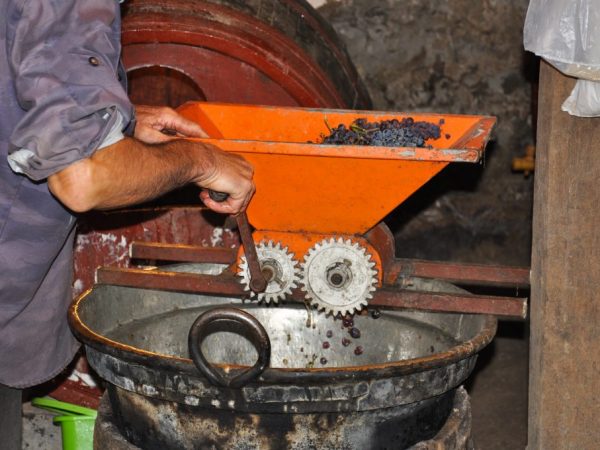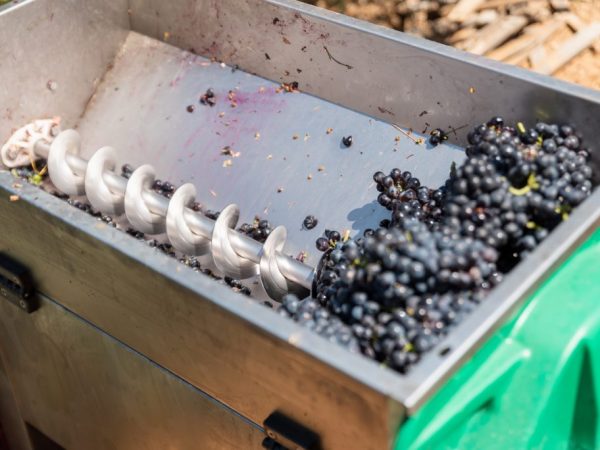How to make a grape crusher yourself
Wine production starts from the moment the harvested crop arrives for processing. Previously, only manual labor was used to crush the bunches (more precisely, foot labor: in special vats, the wine berry was crushed with feet). The first grape crusher appeared in Spain at the beginning of the 17th century.

Self-made grape crusher
Now at the wineries, high-performance installations are used, capable of processing tens of tons of delivered raw materials per hour.
In a household, you can have a small device. But the production of small-sized cars was discontinued in the mid-80s of the last century. Therefore, winegrowers are forced to create them with their own hands or seek help from familiar specialists.
Features of the device
A do-it-yourself grape crusher is made according to several schemes.
- Roller device, two parallel rollers of a special shape rotate in it;
- Crushers with a reciprocating mechanism. With this sequence, portions of raw materials are crushed and transferred to the storage device;
- Grinding action crusher. In them, the activator rotates inside the mass of grapes, its blades actively affect the berries and break them;
- Hammer-type installations have a shaft, on which there is a rotor. Axes are located on the periphery, and hammer plates hang on the axes. When rotating under the action of centrifugal force, the plates diverge in different directions. The incoming raw material ends up on a perforated deck in the impact zone of the plates. The berries are broken up and in the form of a pulp (crushed fruit and berry raw materials) are pushed into the drive;
- Screw type machines. Variable pitch auger available. The grape crusher compresses and moves the incoming mass, the bunches are squeezed, juice is released from them. In the crushed form, the raw materials are squeezed out of the processing zone into the technical process of wine fermentation;
- Eccentric: consist of a cylinder inside which a second cylinder rotates. In a certain position, the raw mass is compressed, the berries are crushed, the juice flows out. The resulting pulp is pressed through the perforated surface of the outer cylinder.
Important! For the manufacture, materials are used that do not enter into chemical reactions with juice: stainless steel, plastic, glass or wood.
After the processing of a certain amount of fruit and berry raw materials is completed, the installations are washed with alkaline solutions, and then rinsed with clean water.
Separators
An important option for a mechanical device is the comb separator. It separates the combs (brushes) from the berries. The principle of operation lies in the fact that the size of the branches significantly exceeds the flow area of the perforation holes.
Design options:
- centrifugal type, the berries are torn off the ridges under the action of centrifugal force;
- shaking off action: the stalk of ripe grapes easily breaks, the bunch is divided into components;
- blade type: the blades are located on a rotating shaft, while a translational movement is created (the entire mass moves along a cylindrical surface with holes, the pulp falls down, and the ridges are brought out in a different direction).
Step-by-step manufacturing instructions
Design development

The crusher can be made by yourself
To make a grape crusher with your own hands, you need to develop a sketch or drawing of the future product.
Of all the variety of designs, it is easiest to make a roller device: it actively crushes the bunches.
In advanced designs, the distance between the rollers is adjustable.
Bunker
Crushers must have a hopper for 10-20 kg of grape mass. For manufacturing, you will have to use plastic, wooden shields or stainless steel sheets.
The hopper has a wide part at the top, and narrows at the bottom: this shape makes it possible to pressurize the product directed to the active working body.
Drive unit
A small homemade grape crusher is equipped with a handle: its axis is a continuation of one of the rollers.
For large-scale processing, an electric drive is needed. However, it should be borne in mind that the shaft rotation speed should be no more than 3-4 r / s. A geared motor with a speed of 180-240 rpm is used. Power will be required about 1-2 kW.
Container for berries
A homemade crusher can be tabletop, or it can be located on its own frame.
The container for the pulp is placed under the product. They use plastic buckets for food products, in which it is easier to transfer the semi-finished product to the fermentation tank.
Manufacturing of elements
Wooden rollers are installed inside. As a basis, birch or linden rolling pins are used.
For the protrusions of the grape crusher, slats (glazing beads) are used.
- The length of the rolling pins is measured.
- Sawed off by 6 glazing beads (12 in total).
- Cylinders (rolling pins) are marked into 6 parts.
- With the help of copper or brass nails, parts of the glazing beads are nailed in place - the rollers are ready.
Hopper elements are cut from plywood with a thickness of 4-6 mm. The fragments are fastened together with copper screws or nails. The finished parts are impregnated with hot drying oil or a primer for outdoor use (double coating).
For a homemade grape crusher and roller installation, closed bearings are selected, which are fixed on the outside of the bunker. Housings made of stainless steel or bronze are used.
Electric crusher installation

The electric drive will facilitate the processing of berries
The assembly must be done on the frame. It can be made from wooden blocks with a cross section (40x40 mm) or welded from shaped pipes (25x25 mm).
The electric grape crusher is equipped with a geared motor with a rotational speed of 180-240 rpm. A chain drive is used to drive the shaft of the comb separator. You can use bicycle sprockets.
Installation of a comb crusher
This grape crusher has a ridge separation mechanism, which is mounted below the rollers. It is a semi-cylinder made of stainless mesh with 15x15 mm cells.
The shaft is made from birch cuttings. Blades are made from a plate with a thickness of 0.8-1.5 mm (stainless steel). They are attached to the shaft with copper or brass screws. Set so that during rotation there is movement in the horizontal plane.
A half-cylinder is bent from a stainless mesh. The distance between the blades and the wall is not more than 5 mm.
Crushed berries fall through the cells, and the ridges move to unload.
Operating rules
Check the quality of the separation of the comb from the berries and the amount of uncrushed grapes.
- A portion of grape bunches is prepared, usually 10-20 kg.
- A container for collecting the pulp is installed.
- Grapes are poured into the bunker.
- The electric motor turns on.
- The prepared portion of the raw material is processed.
Now you need to analyze the results. The mass of the ridges is weighed, and then the resulting pulp is weighed.
The sum of both masses is compared with the value of the mass of the feedstock. Lost mass is refined. Homemade grape crushers lose no more than 1-2% of the original weight.
Along the way, the number of ridges caught in the pulp is analyzed. The penetration of no more than 1% of the particles separated in the comb separator is considered satisfactory. If the result is outside the specified tolerance, the workflow is analyzed. Ways are being sought to improve efficiency.
The quality of the pulp is checked. No more than 3% of undamaged berries are allowed to pass. The efficiency can be improved by reducing the gap between the rollers. Some growers install a two-tier roller system, where the raw material goes through double grinding.
Advice
- For grapes, a mechanical grinder is suitable, which uses a roller grinder.
- The electric drive will allow mechanizing the grape processing process.
- Based on the test results, the efficiency of a small-sized grape crusher with a ridge separator is specified.

